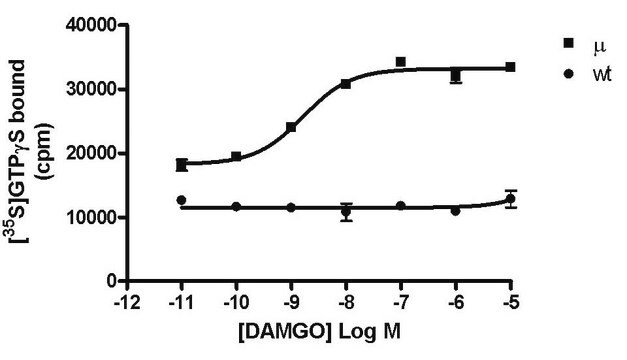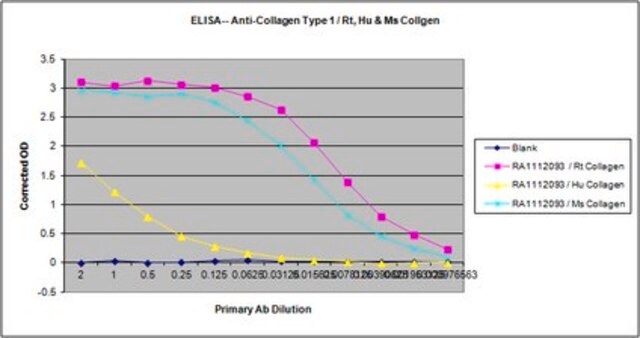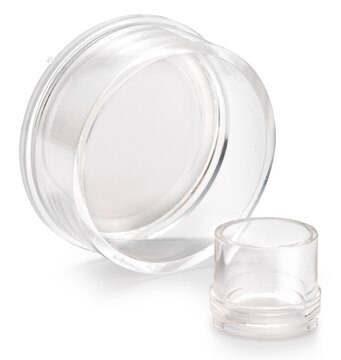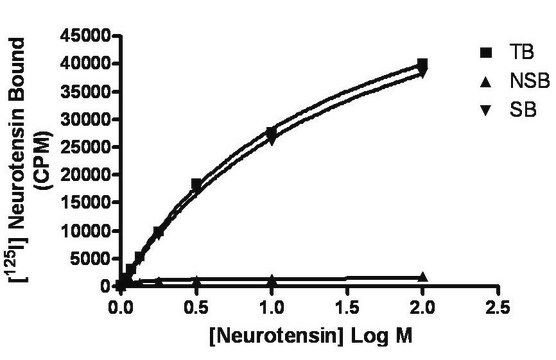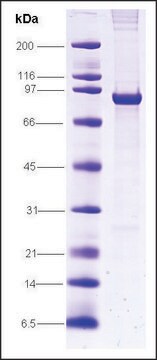HTS112M
ChemiScreen Recombinant Human Glucagon Receptor Membrane Preparation
Human glucagon / GCG GPCR membrane preparation for Radioligand binding Assays & GTPγS binding.
Sinónimos:
ChemiSCREEN Receptor Kit, Glucagon Receptor Membrane Prep, Human Glucagon Receptor Prep
About This Item
Productos recomendados
biological source
human
Quality Level
recombinant
expressed in Chem-1 cells
manufacturer/tradename
ChemiScreen
Chemicon®
technique(s)
ligand binding assay: suitable (GTPγS)
radioligand binding assay (RLBA): suitable
NCBI accession no.
UniProt accession no.
shipped in
dry ice
General description
HOST CELLS: Chem-1, an adherent mammalian cell line with no endogenous glucagon receptor expression.
Quality
1 unit = 5 μg
Bmax for [125I] glucagon binding: 16.7 pmol/mg protein
Kd for [125I] glucagon binding: ~ 3.09 nM
Signal:background and specific binding values obtained in a competition binding assay with varying amounts of Glucagon receptor membrane prep:
| 10 µg/well | 5 µg/well | |
|---|---|---|
| Signal:Background | 10.1 | 35 |
| Specific Binding (cpm) | 33315 | 36252 |
Specifications
RECOMMENDED ASSAY CONDITIONS: Membranes are mixed with radioactive ligand and unlabeled competitor in binding buffer in a nonbinding 96-well plate, and incubated for 1-2 h. Prior to filtration, a GF/C 96-well filter plate is coated with 0.33% polyethyleneimine for 30 min, then washed with 50mM HEPES, pH 7.4, 0.5% BSA. Binding reaction is transferred to the filter plate, and washed 3 times (1 mL per well per wash) with Wash Buffer. The plate is dried and counted.
• Binding buffer: 50 mM Hepes, pH 7.4, 5 mM MgCl2, 1 mM CaCl2, 0.2% BSA, filtered and stored at 4°C
• Radioligand: [125I]-glucagon (Perkin Elmer#:NEX-207)
• Wash Buffer: 50 mM Hepes, pH 7.4, 500mM NaCl , 0.1% BSA, filtered and stored at 4°C.
One package contains enough membranes for at least 200 assays (units), where a unit is the amount of membrane that will yield greater than 10-fold signal:background with [125I]-labeled glucagon at 1 nM
Physical form
Packaging method: Membrane proteins were adjusted to 0.5 mg/ml in 1 ml packaging buffer, rapidly frozen, and stored at -80°C.
Legal Information
Storage Class
12 - Non Combustible Liquids
wgk_germany
WGK 2
flash_point_f
Not applicable
flash_point_c
Not applicable
Certificados de análisis (COA)
Busque Certificados de análisis (COA) introduciendo el número de lote del producto. Los números de lote se encuentran en la etiqueta del producto después de las palabras «Lot» o «Batch»
¿Ya tiene este producto?
Encuentre la documentación para los productos que ha comprado recientemente en la Biblioteca de documentos.
Nuestro equipo de científicos tiene experiencia en todas las áreas de investigación: Ciencias de la vida, Ciencia de los materiales, Síntesis química, Cromatografía, Analítica y muchas otras.
Póngase en contacto con el Servicio técnico
